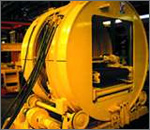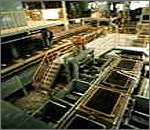Introduction: Vertical molding technique was invented in 1950's in an attempt to reduce the cost of the casting. Vertical and flaskless molding system is fully automated. In the end of the fifties foundry industry, as all the others, called constantly for reduction of the labor costs, higher productivity casting quality and improved dimensional accuracy.
Flaskless molding on the other hand is a process that used flask, wher the sand filled flask is used for a repeated number of casting process. Flaskless molding sysem is fullt automated so that maximum output can be received.
 Process:
Process: This process can be a sand or a green sand molding variation, that has been automated for speed and high volume out-put, of identical castings. The basic process of solidfying the molten metal is same as the dry sand casting and green sand casting methods.
Despite any misconceptions, a flask-less molding does use flasks. The flasks, " holds the whole thing together ". A Flask must be used on all sand molding for the containment of the sand, while the sand is firmed about the pattern. In flask-less molding, in either a vertical or a horizontal stance, a sand filled flask is rebuilt and used over and over, in this totally mechanized, and automated sand molding process. In sand casting or green sand casting, a tight fitting, individual – most likely sand filled flask – is used for each mold produced.
Flask-less Molding provides a mold hardness that is consistent through out the mold. The operator can adjust to different cope, drag heights and total squeeze pressure to accommodate different mold densities and mold hardness to meet the molding application. The operator can adjust the sand fill allowing the adjustment for variations in each pattern. It is possible produce complex molds and mold with deep pockets, which are difficult with traditional, normal sand casting procedures
Rapid core setting, easy inspection of cores used, utilization of existing tooling, high casting quality, reduced finishing time, quick pattern change, exceptional mold to mold consistency, high productivity are some of the many reasons to use flask-less molding. Examples of usage would be: Any thing you can make in a sand mold, but you want it made for high volume, high production.
 Applications:
Applications: Examples of usage are engine blocks, transmission housings, gear housings, pump housings, air movement components ( fan blades), hubs, shafts, tubes, rectangles, squares, holes, no holes, the list is endless.
Advantages:
- High productivity
- Low labor requirement
- Dimensional castings accuracy
- Reliable for nearly cent percent efficiency.


